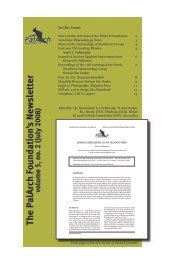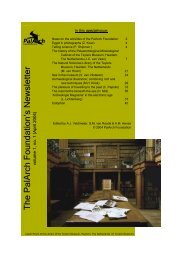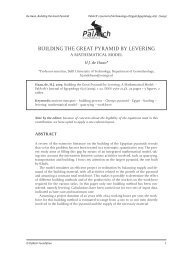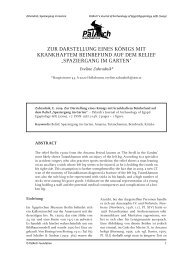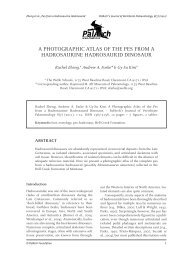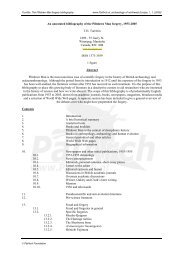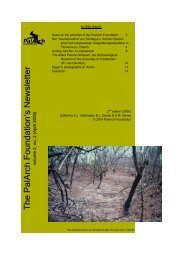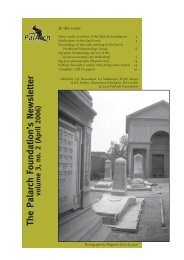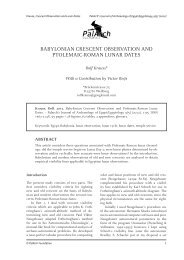neural spine bifurcation in sauropod dinosaurs of the - PalArch
neural spine bifurcation in sauropod dinosaurs of the - PalArch
neural spine bifurcation in sauropod dinosaurs of the - PalArch
You also want an ePaper? Increase the reach of your titles
YUMPU automatically turns print PDFs into web optimized ePapers that Google loves.
Wedel & Taylor, Neural Sp<strong>in</strong>e Bifurcation <strong>in</strong> Sauropods <strong>PalArch</strong>’s Journal <strong>of</strong> Vertebrate Palaeontology, 10(1) (2013)<br />
Figure 17. Apatosaurus parvus CM 563/UWGM 15556<br />
caudals 8 and 7 <strong>in</strong> right lateral (top) and posterior view,<br />
from Gilmore (1936: plate 33). Arrows highlight shallow<br />
antero-posterior notches <strong>in</strong> <strong>the</strong> tips <strong>of</strong> <strong>the</strong> <strong>neural</strong> <strong>sp<strong>in</strong>e</strong>s.<br />
592 already displays adult morphology. Therefore,<br />
no ontogenetic change has been demonstrated.<br />
Camarasaurus<br />
The ontogenetic series (Woodruff & Fowler,<br />
2012: 5 and figure 8) consists <strong>of</strong>:<br />
• OMNH 1417;<br />
• AMNH 5761.<br />
OMNH 1417 is an isolated cervical <strong>neural</strong><br />
<strong>sp<strong>in</strong>e</strong>, and <strong>the</strong> pictured vertebra <strong>of</strong> Camarasaurus<br />
supremus AMNH 5761 is a posterior<br />
cervical. In C. grandis and C. lewisi, all<br />
<strong>of</strong> <strong>the</strong> cervical vertebrae eventually develop<br />
at least a shallow notch <strong>in</strong> <strong>the</strong> tip <strong>of</strong> <strong>the</strong> <strong>neural</strong><br />
<strong>sp<strong>in</strong>e</strong>, but as discussed above <strong>the</strong>re seems<br />
to be some variation between Camarasaurus<br />
species, and, likely, between <strong>in</strong>dividuals.<br />
In <strong>the</strong> absence <strong>of</strong> <strong>in</strong>formation about its serial<br />
position and <strong>the</strong> species to which it belonged,<br />
<strong>the</strong> lack <strong>of</strong> <strong>bifurcation</strong> <strong>in</strong> OMNH 1417<br />
is un<strong>in</strong>formative; it could belong to an anterior<br />
cervical <strong>of</strong> C. supremus that would not<br />
be expected to develop a <strong>bifurcation</strong>. Therefore,<br />
no ontogenetic change has been demon-<br />
strated. There is evidence that <strong>neural</strong> <strong>sp<strong>in</strong>e</strong><br />
<strong>bifurcation</strong> developed ontogenetically <strong>in</strong> Camarasaurus,<br />
but it comes from <strong>the</strong> juvenile<br />
C. lentus CM 11338, described by Gilmore<br />
(1925), and <strong>the</strong> geriatric C. lewisi, described<br />
by McIntosh, Miller et al. (1996) – see above<br />
for discussion.<br />
Summary<br />
The ‘ontogenetic’ series <strong>of</strong> Woodruff & Fowler<br />
(2012) cannot parsimoniously be <strong>in</strong>terpreted<br />
as ontogenetic series. In all <strong>of</strong> <strong>the</strong> diplodocid<br />
presacral vertebrae and <strong>in</strong> Camarasaurus, <strong>the</strong><br />
smallest elements <strong>in</strong> <strong>the</strong> series are isolated vertebrae<br />
or <strong>neural</strong> arches for which <strong>the</strong> serial position<br />
is almost impossible to determ<strong>in</strong>e and<br />
even <strong>the</strong> taxonomic identifications are suspect<br />
(e.g. <strong>the</strong> OMNH juvenile material – <strong>the</strong> criteria<br />
for reliably dist<strong>in</strong>guish<strong>in</strong>g <strong>the</strong> <strong>neural</strong> arches <strong>of</strong><br />
Apatosaurus and Camarasaurus are not stated).<br />
The larger vertebrae <strong>in</strong> <strong>the</strong> presacral series are<br />
all compromised <strong>in</strong> various ways: one <strong>in</strong>cludes<br />
a probable adult masquerad<strong>in</strong>g as a juvenile<br />
(MOR 790 8-10-96-204 <strong>in</strong> <strong>the</strong> anterior cervicals),<br />
one is out <strong>of</strong> order by centrum size (MOR 790<br />
7-26-96-89 and MOR 592 <strong>in</strong> <strong>the</strong> posterior cervicals),<br />
and two show no change <strong>in</strong> degree <strong>of</strong><br />
<strong>bifurcation</strong> from <strong>the</strong> middle <strong>of</strong> <strong>the</strong> series to <strong>the</strong><br />
upper end (MOR 592 and CM 84/94 <strong>in</strong> <strong>the</strong> anterior<br />
and posterior dorsals). The shallow longitud<strong>in</strong>al<br />
<strong>bifurcation</strong> <strong>in</strong> <strong>the</strong> MOR 592 caudal vertebra<br />
is similar to those found <strong>in</strong> caudal vertebrae<br />
<strong>of</strong> adult diplodocids, and is not antecedent to<br />
<strong>the</strong> transverse <strong>bifurcation</strong>s discussed <strong>in</strong> <strong>the</strong> rest<br />
<strong>of</strong> <strong>the</strong> paper.<br />
To <strong>the</strong> extent that <strong>the</strong> taxonomic hypo<strong>the</strong>ses<br />
<strong>of</strong> Woodruff & Fowler (2012) rely on an ontogenetic<br />
<strong>in</strong>crease <strong>in</strong> <strong>bifurcation</strong> <strong>in</strong> diplodocids,<br />
<strong>the</strong>y are suspect. That will be <strong>the</strong> subject <strong>of</strong> <strong>the</strong><br />
next two sections.<br />
Is Suuwassea a Juvenile <strong>of</strong> a Known<br />
Diplodocid?<br />
In <strong>the</strong> abstract, Woodruff & Fowler (2012:1)<br />
wrote: “On <strong>the</strong> basis <strong>of</strong> shallow <strong>bifurcation</strong> <strong>of</strong><br />
its cervical and dorsal <strong>neural</strong> <strong>sp<strong>in</strong>e</strong>s, <strong>the</strong> small<br />
diplodocid Suuwassea is more parsimoniously<br />
<strong>in</strong>terpreted as an immature specimen <strong>of</strong> an already<br />
recognized diplodocid taxon.”<br />
We test this hypo<strong>the</strong>sis <strong>in</strong> two ways. In this<br />
section we consider whe<strong>the</strong>r it is plausible,<br />
based on comparative morphology, that Suu-<br />
© <strong>PalArch</strong> Foundation 20



